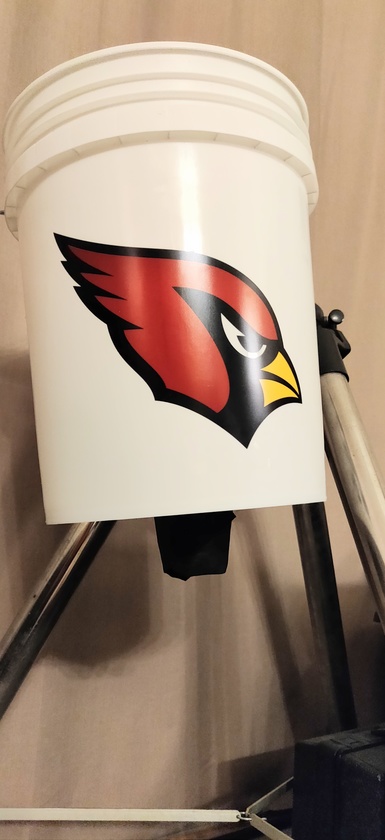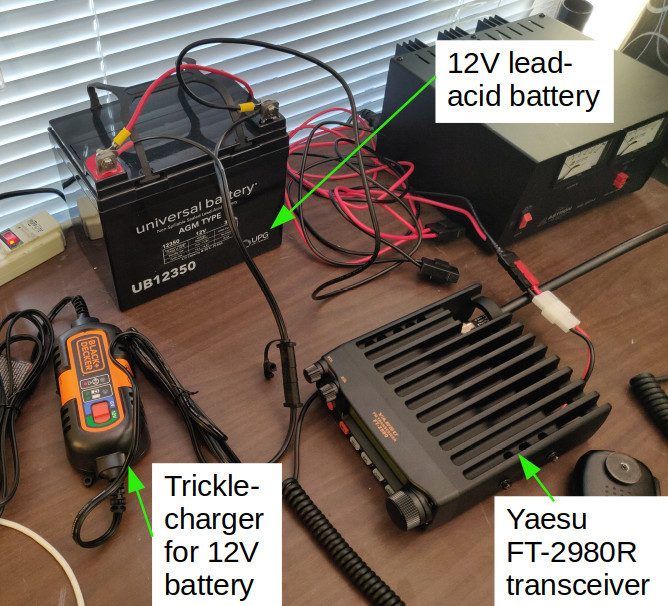Here are the notes from my talk today:
Motivation:
- Power goes down occasionally under normal cicrumstances. These are not normal times.
- Attacks on infrastructure are becoming more common.
- In modern situations of significant social unrest, power is often intermittent. Down for weeks.
- Being able to charge communication devices, at a minimum, is very useful.
Basic components overview:
- Panels themselves: Photons hitting the panels create a voltage potential difference across the solar cells. The more solar cells, and the more incoming light, the higher the voltage.
- Charge controller: Takes that high voltage, low-current output from the panels and turns it into a known lower voltage, usually 12V or 24V. This process can me more or less efficient, depending on the technology used. PWM vs MPTT and efficiency difference of 30%.
- Battery(s): Stores energy so you can use a higher current than is available from the output of the charge controller at a given time. You will almost always need a battery of some sort in your system, even for very small systems.
- DC voltage converter: To go from whatever voltage you store in your battery to what you actually need to power your DC device. Many, many devices have 'car charging' adapters and you can use those if you have 12V batteries.
- AC Inverter: Creates 120V AC power (or 240, or potentially whatever) so you can run regular devices you have plugged into the wall of your home.
- Cables: Higher current = larger cable. Also pay attention to size of the lugs on each piece of equipment.
What do you want to power?
- How much current do you need, and how often? Do you need AC power or no?
-- Devices you charge up to use: Radio, cell phone, battery powered lights, night-vision devices. Not much current needed, so the only questions are how many will you need to run, for how much time, and voltage / connector compatibility.
--- Low Power Examples: Phone, tablet, handheld radios, some night vision devices, weapon light batteries, USB external batteries, rechargeable batteries for other devices like lights.
--- Higher power: Battery powered tools as long as you can charge off of a 12V car outlet. This includes 12V freezers, if you have one, but I wouldn't go out an buy one if you don't. Too small for the cost.
-- Devices that require AC power available at time of use:
--- Low power examples: Non-battery power tools, laptops that you don't have a 12V charger for, computers / monitors, security cameras, small kitchen appliances, etc. Tons of examples.
-- Higher power (the good stuff): Freezer, microwave, arc welder, CNC machinery, small well pumps...
How to know what you can and cannot power:
-
USB charged devices: USB solar panels may not produce enough current to actually charge the device. Charge a USB battery instead, and then the device from that.
-
12V Charged devices: Check the discharge current rating for your batteries. Li-Ion batteries can have very low discharge rates, lead acid will almost certainly have plenty of current. 20 amps is probably plenty for devices that are 12V powered, without using an inverter.
-
Devices powered from an inverter:
-- Now you have to worry about both current from the battery to the inverter, and from the inverter to the device. Make sure batteries can handle whatever current your inverter can draw, and that your inverter can handle the requirements of the device you want to run.
-- Unless you know your devices won't mind 'dirty' power, make sure you get a Pure Sine Wave inverter. This means that it's built better and produces the expected consistent AC signal, and not something weird. -
Current draw: Continuous and surge
-- Many devices will require more current for a brief period of time, often at startup. Anything with a compressor will draw a bunch of current when it kicks on.
-- Numbers for common devices:
--- Freezer: N watts continuous, N watts surge
--- Small air compressor: N watts continuous, N watts surge
-- Microwave: N watts continuous, no surge
-- Circular saw, mitre saw, angle grinder, etc: N watts continuous, N watts surge.
-- Have an idea of what you want to run, and for how much time per day, and then look up the power usage. You can also use a Kill-A-Watt to check how much total power is used by a device for a given use case. -
Inverters will typically have a rating for continuous power and then a higher surge power also, so just make sure both are sufficient for your use case. Remember that you may be running more than one device at a time!
Notes about batteries:
- Lead acid batteries require regular maintenance. This is not at all a big deal, literally pouring in some DI water into a hole. You can go further than that to maximize performance and longevity of the batteries, but it isn't really necessary. They'll last a long time if you just top them up monthly.
-- ALSO, flooded lead acid batteries must not go below a certain charge in order to maximize life. I enforce this with a battery protector that prevents the voltage from dropping below the magic number by disabling the inverter.
-- Lithium ion batteries are great, no maintenance needed, generally they have protection circuits built in that prevent you from breaking them, but are roughly ~5x the price per amp-hour, even considering the discharge limits of lead-acid.
-- Somewhere in between are sealed-gel and sealed-agm batteries. Less maintenance, but won't last as long as a reasonably maintained lead-acid. And more expensive. Flooded lead acid is the way to go, IMO. - Batteries 'in series' will increase the voltage. So 2 12V in series means 24V for the controller and inverter. Higher voltage setups tend to me more efficient and have a higher current rating.
- If you have batteries in series for 24V, don't use 12V from a single battery because the pair will become imbalanced, and that will hurt longevity. To make this work in an efficient way requires a bit of engineering.
General Notes:
- Select quality components from known suppliers if you actually want to have this as an emergency backup.
- If you're just doing a minimal system to charge your comms devices, this can be really cheap and there's no reason not to. Buy any USB output panel system, at least 20 W, and a decent USB battery if you don't already have one. Think through what you want to charge, and then get adapters as needed. Many devices have adapters for charging via USB.
- It's easy to have more power than you need coming from the panels, the hard part is the rest of the system.
- If you're going the 12V only route, you still want a battery protector unless you plan to manually monitor it. Automatic is more reliable than manual...
- If you don't need reliable power, or power at night, you can go with a single battery.
- MPTT charge controllers are a huge advantage unless the system is very small.
- Inverters can be expensive for good, reliable ones with a high current rating. Mine was the single most expensive part.
- Inverters are more efficient than I expected, or good ones are, but it is still somewhat more efficient to charge DC devices with DC adapters if you care.
Assembly notes:
- Be careful, don't short out your batteries, and have the panels out of the sun while you're assembling and wiring.
- Anything directly above lead-acid batteries will get melted over time by a small release of hydrogen gas that happens while charging. Keep lead acid batteries in a fairly open space to let that dissipate.
- Bigger cables aren't much more expensive. No real reasong to go cut corners on that part.
- Breakers are useful for shutting things off when you want to change something or do maintenance. Breakers > fuses for this reason.
- Keep track in your mind of what the voltages are at what point, or label them.
- Wiring things into your house permanently is hard. Extension cords and power strips are easy.
Here is my earlier post with information on the parts lists for different builds:
https://tucsonamericancontingency.locals.com/post/151015/emergency-solar-power
@Johngaltman and I will be documenting the process of assembling his system which is a clone of what I built.
[I'm reposting this to the top because we have a number of people who still need to get their ham license!]
For anyone near Tucson who hasn't already gotten your Ham license or is interested in upgrading what you already have, here is some info based on my experience of getting my Technician and General licenses recently:
- Free testing is available monthly in Tucson. Next event is March 8th @ 7PM . https://k7rst.org/testing.html
-- There is no preregistering. You just show up, but I highly recommend being there a half hour early to get in line. I was there 15 minutes early and waited a little more than an hour before it was my turn to take the test, and then there's more waiting in between exams if you take more than one.
- There is also an online testing option available now. It generally costs ~$15 and you need fairly decent internet, a computer with a webcam, and a phone with a camera. (Thanks to @freebirdie for sending me the info on this).
-- Look here to find a session that's open: ...
I've been meaning to document this for quite awhile but things kept getting in the way. I've been writing this slowly over the past several weeks now, and am finally ready to post it!
I've created a simple automated planter for low-effort food gardening that seems to work pretty well for a a decent number of different plants. This was originally inspired by Larry Hall's "Rain Gutter Grow System", and then I fused it with the general concept of bottom-watered reservoir planters, which you can find everywhere.
Larry Hall's video should show up at the end of this post:
One implementation of a standard, non-automatic, bottom-watered reservoir planter:
https://www.amazon.com/GroBucket-Watering-sub-irrigated-Container-portable/dp/B079CT29RZ/
My goals were to keep costs relatively low, minimize water usage, and minimize the weekly time I need to put in to maintain the garden. I don't mind spending a bit more time to get something set up if that means I don't have to remember to do another ...
I've recently upgraded my VHF transceiver capability, and it has made a huge difference. We ask everyone to have a radio of some sort, and the cheapest Ham radio that works is the Baofeng UV-5R. I don't want to ask people to spend a ton of money, but from my own experience I do think upgrading is worth the extra expense. The receive electronics on the UV-5R are low-quality so they don't seem to work well with external antennas. A lot (or all) of the advantage you'd get from putting an external antenna up on your roof is lost when you plug it into the UV-5R.
The tranceiver I bought is the Yaesu FT-2980R:
https://www.hamradio.com/detail.cfm?pid=H0-015771
Unfortunately they just raised the price by $20, but it's still only $150 (or closer to $170 with shipping and tax). Note that it's a VHF only radio and is very simple compared to the more expensive models, but it is a beast of a machine that can dump 80W of power if needed.
This radio works well with every external antenna I've tried, and it's well suited to ...


























